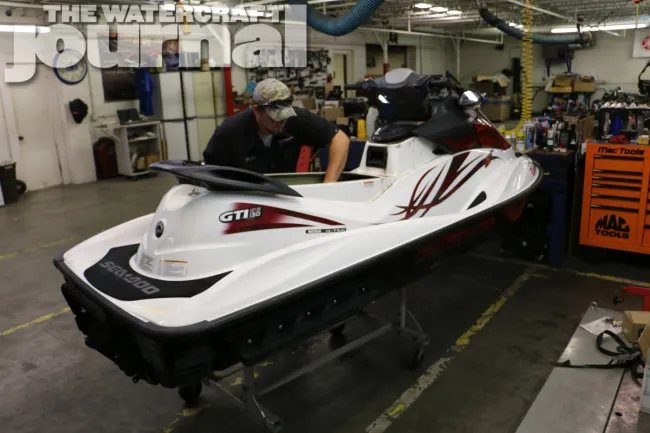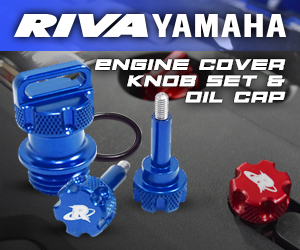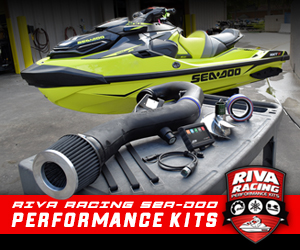While there’s a great deal of detail that could be poured into every step of the tips listed below, we want to share one of the most bare-bones, comprehensive check lists necessary to not only prepare your personal watercraft for a long winter’s nap, but also to properly wake it from hibernation, all courtesy of the crew at PWC Muscle (and its sister site, www.seadooforum.com). Again, it’s lengthy but worth the review:
Winterizing:
Winterizing your boat for the majority of us is the most dreaded day of the year. Warm weather is gone and so starts the wait for spring temperatures so we can hit the water again next season. Take these protective measures to assure your boat will greet you with a happy face when warm weather welcomes you again in a few months.
Standard Winterization
1) Run a fogging solution through the boat engine while it is running to protect internal parts
2) Spray a protective anti-corrosion film on the external parts of engine
3) Drain the engine block and manifolds and fill the engine with anti-freeze
4) Drain the lower unit gear oil and refill with fresh oil (stern drives only)
5) Grease all external fillings on stern drives
6) Disconnect the battery/batteries and store somewhere warm
7) Cover your boat
Optional Winterization
1) Remove spark plugs and spray oil on cylinders, then replace spark plugs
2) Change engine oil and filter
3) Remove prop and grease prop shaft
4) Add fuel stabilizer to prevent condensation in gas tank (run engine briefly to flush stabilized gas through fuel injectors and carburetor)
5) Winterize fresh water system
6) Remove outdrive and grease U-Joint
De-Winterizing
Prepare Your Vessel for the Spring and Summer
So, you have got that itching spring fever to uncover the boat and get her wet for the first time this season. There is nothing worse than being gathered at the dock with a boat-load of people and you turn the key and…rrr..rrr..rrr…and nothing. It is likely this will happen if you do not take the time to de-winterize your boat. Do an inspection before setting out on the first trip of the season. To avoid any embarrassment and frustration, use the following pre-launch checklist to get your boat as ready for the boating season as you are.
Oil Check
If you did not change the engine oil when you put the boat up for the season, now is the time to do it. Make sure you change the oil filter also. Check the oil in the outdrive.
Battery Inspection
1) Reattach the cables.
2) Make sure the terminals are not corroded. If so, wipe them clean. If your battery takes water, fill it up. A dry battery is a bad battery. (I learned that the hard way.) With a battery tester, check the volts and amps. Does it have juice? If it is charged and still no luck, it may be time to buy a new battery.
Cooling System
Hopefully you drained the cooling system if you live in a cold winter climate to prevent freezing. If so, fill ‘er back up. Rinse out the strainer and check the hoses for cracks.
Fuel System
You also should have topped off the tank with gas to prevent any moisture and condensation forming in the tank and diluting the gas. Change the fuel filter. Make sure the fuel line is attached and not cracked. In the winter these hoses can become dry and brittle.
Distributor
Take the distributor cap off and clean it out. Corrosion could have occurred during the winter. Make sure all connections are restored.
Belts
Tighten the belts if needed. You should only be able to push the belt slightly down. If the belts do not fit snugly in their pulley grooves, they may be worn and in need of replacement. Belts that are not tight will wear faster because they will likely begin to slip. The alternator belt usually wears faster than the others. A sign of a worn belt is black soot somewhere in the vicinity of the pulley.
Other Things That Should Not Be Ignored:
Change the spark plugs
Lubricate the engine with WD-40
Check all hoses
Check power steering/cables
Test the bilge pump
Replace the drain plug
Check rudder and shafts
Inspect the prop
Test the horn
Test the VHF radio
Check the trim
Inspect personal flotation devices
Check the fire extinguisher expiration date
Make sure the anchor in on board
* The above de-winterizing tips are only a list of suggested things to do your boat that I’ve collected over the years. Each boat may vary as to what needs to be done to de-winterize it. For complete instructions please see your boat’s owners manual or consult your boat mechanic.









